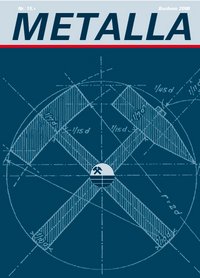2015 ist Journal 15.1 der Zeitschrift METALLA erschienen. Die Leserschaft erwartet wie üblich ein Portfolio an vielfältigen Beiträgen und Themen.
Two communities have emerged in archaeometallurgy: the archaeologists, largely educated in the humanities, and the material scientists. Killick (2015; Pearce, 2016) has illustrated the non-communication and mutual lack of interest in the debates between the two traditions, one focused on the social and symbolic aspects of metalwork, the other interested in techniques of analysis and chemical and mineralogical processes. This session aims to build bridges the two approaches, encouraging collaborative research goals, and thereby to fuse the two in a new understanding. Archaeometallurgists have their own conferences and journals, so that archaeometallurgical articles rarely appear in mainstream journals, and sessions at general archaeological congresses, like the EAA, are often dominated by discussion of technique rather than the contribution of archaeometric data to the resolving specific archaeological problems. Such sessions are often deserted by the generalist archaeologists who are not interested in technical problems. Cultural archaeologists are also to blame for this situation, especially because too few really have the specific skills (especially statistical) to use archaeometallurgical data, or an understanding of what specific analytical techniques can and crucially cannot tell us. We welcome papers from either tradition, that attempt to bridge the divide by discussing the problems inherent in combining the traditions or that interpret archaeometrical data within a framework of archaeological data and hypotheses.
Situated between the Caspian and Black seas, the mountains of the Caucasus are not a barrier but give access to Anatolia and beyond to Mesopotamia through several passes. Influences and exchanges have always been a significant feature of the different ancient cultures. Among the various materials that explain these cultural interactions metal played an important role. The beginnings of metallurgy (VIth-IIIrd millennia B.C.) corresponds to a technological and conceptual revolution (radical transformation of the material) which had important cultural implications. In order to understand the importance of metal the definition of metallurgy is taken in its largest meaning: from the ore to the objects including their recycling. The aim is to explain the technical aspects of extractive and manufacturing metallurgies and the cultural consequences of the apparition of a new material – metal – in the cultures of the Caucasus and beyond. This problem is approached by several studies combining archaeology, geology, metallogeny and metallurgy.
Bezug der aktuellen Ausgabe: metalla@bergbaumuseum.de oder +49 234 282538-29
Preis: Ein Einzelheft kostet 20,00 €
- A. Courcier, A. Gasanova & A. Hauptmann: Ancient metallurgy in the Caucasus during the Chalcolithic and Early Bronze Age: recent results from excavations in Western Azerbaijan, pp. 21-34
Download (PDF) - Two communities have emerged in archaeometallurgy: the archaeologists, largely educated in the humanities, and the material scientists. Killick (2015; Pearce, 2016) has illustrated the non-communication and mutual lack of interest in the debates between the two traditions, one focused on the social and symbolic aspects of metalwork, the other interested in techniques of analysis and chemical and mineralogical processes. This session aims to build bridges the two approaches, encouraging collaborative research goals, and thereby to fuse the two in a new understanding. Archaeometallurgists have their own conferences and journals, so that archaeometallurgical articles rarely appear in mainstream journals, and sessions at general archaeological congresses, like the EAA, are often dominated by discussion of technique rather than the contribution of archaeometric data to the resolving specific archaeological problems. Such sessions are often deserted by the generalist archaeologists who are not interested in technical problems. Cultural archaeologists are also to blame for this situation, especially because too few really have the specific skills (especially statistical) to use archaeometallurgical data, or an understanding of what specific analytical techniques can and crucially cannot tell us. We welcome papers from either tradition, that attempt to bridge the divide by discussing the problems inherent in combining the traditions or that interpret archaeometrical data within a framework of archaeological data and hypotheses.
- A. Courcier, D. Kuparadze & D. Pataridze: Archaeometallurgical researches on the early beginnings of metallurgy (VIth-IIIrd millennia BC) in the Caucasus: an example of interdisciplinary studies, pp. 35-50
Download (PDF) - Situated between the Caspian and Black seas, the mountains of the Caucasus are not a barrier but give access to Anatolia and beyond to Mesopotamia through several passes. Influences and exchanges have always been a significant feature of the different ancient cultures. Among the various materials that explain these cultural interactions metal played an important role. The beginnings of metallurgy (VIth-IIIrd millennia B.C.) corresponds to a technological and conceptual revolution (radical transformation of the material) which had important cultural implications. In order to understand the importance of metal the definition of metallurgy is taken in its largest meaning: from the ore to the objects including their recycling. The aim is to explain the technical aspects of extractive and manufacturing metallurgies and the cultural consequences of the apparition of a new material – metal – in the cultures of the Caucasus and beyond. This problem is approached by several studies combining archaeology, geology, metallogeny and metallurgy.
